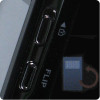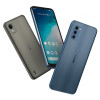Review: Samsung UpStage
Screen
The small screen on the phone side is only three lines tall - three very small, cramped lines - with a small bit of room left below for soft key labels. Though Sprint limited the number of things you can do on this screen, even doing those is frustrating, as you will be squinting all the time. Not only does this screen use a small font, but it uses anti-aliasing that makes the text blurry too.
Using the media face's screen is a joy by comparison. It is just a standard 176 x 220 display, but it can still display much more than the phone side, and more clearly. It is vivid and fairly sharp, especially for a such a large screen with this resolution.
Signal
The battery wallet may increase your talk time, but it decreases signal strength. The UpStage consistently got an additional bar of signal when it was out of the wallet. Normally the signal was strong enough that leaving it in the wallet didn't really make a difference. However the UpStage can't quite hold a signal like some other phones. So the only way it could consistently pass our vault test was out of the case. In the case it simply couldn't hold on to a call well enough.
Sound
Like most MP3 players, the UpStage is meant to be enjoyed through headphones. There is a small speaker on the phone side which performs all functions. When held to the ear for calls, the lone speaker is plenty loud. In fact, it is usually loud enough when set at about half way. However the speaker is not quite loud enough as a speakerphone or ringer. It works for relatively quiet situations just fine, but especially when the UpStage was in its battery wallet, we would miss calls in loud environments.
Luckily the UpStage has an earthquake-scale vibrating alert, which can be used in addition to or as a substitute for the ringer. With vibration on, you'd have to be in a drug-induced coma to miss a call.
Battery
After they squeezed two screens, two keyboards, and all the necessary cell phone components into the UpStage, there wasn't much room left for the battery. If you don't put the phone in the battery wallet, you'll only get about a day of light use out of the phone. Use it more often and you'll be charging every night, and on your afternoon commute. In fact, the battery is so small it only can last for about a day and a half on standby, without touching the phone at all.
Add the battery wallet and then you can start to use the UpStage as it was intended. Leave the UpStage untouched and it will stay alive for a week. You'll get about three days of calling, listening to tunes and surfing. If you choose to listen to your tunes and take your calls over Bluetooth, subtract a day.
The battery wallet charges through the phone. You attach the wallet to the phone and plug the phone into the charger. The phone battery is charged first, then the wallet. If attached, the UpStage will use power from the battery wallet before draining its built-in battery. However if the built-in battery gets too low, attaching the wallet will not save you. You'll have to plug the UpStage in before it will work again.


 Preview: Samsung UpStage
Preview: Samsung UpStage
 iPhone 15 Series Goes All-In on USB-C and Dynamic Island
iPhone 15 Series Goes All-In on USB-C and Dynamic Island
 TCL's Newest 5G Phone for US is Most Affordable Yet
TCL's Newest 5G Phone for US is Most Affordable Yet
 Nokia Refreshes Entry-Level Android Lineup for US
Nokia Refreshes Entry-Level Android Lineup for US
 OnePlus' New Mid-Range Phone Has a 108 Megapixel Camera
OnePlus' New Mid-Range Phone Has a 108 Megapixel Camera
 Samsung UpStage M620
Samsung UpStage M620




